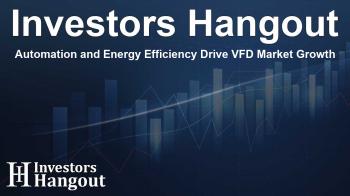Automation and Energy Efficiency Drive VFD Market Growth

Understanding the Variable Frequency Drive Market Growth
The Variable Frequency Drive (VFD) market is on a significant rise, predicted to escalate to USD 38.99 billion in the coming years. This growth is propelled by key factors such as increased automation and a rising focus on energy efficiency within various industrial sectors.
The Accelerating Demand for Energy Efficiency
VFDs are gaining traction because they offer remarkable energy savings and optimized motor control. Industries ranging from manufacturing to HVAC systems benefit from the ability to control motor speeds accurately, resulting in reduced energy consumption. By only utilizing as much power as needed, VFDs can achieve savings of up to 30% in systems that operate continuously.
Impact on Operational Efficiency
This technology not only contributes to energy savings but enhances overall operational flexibility. VFDs ensure smooth acceleration and deceleration of machinery, which lessens the mechanical stress on equipment and prolongs its lifespan. This capability not only allows for better performance but also translates into lower maintenance costs, thus improving productivity across various sectors.
Integration with Smart Manufacturing
As industries advance into what is termed Industry 4.0, VFDs play an integral role in smart manufacturing. They provide seamless integration with digital control systems, facilitating automated processes that are fundamental to modern manufacturing environments. This synergy enhances operational reliability while ensuring compliance with today’s stringent energy consumption regulations.
Market Segmentation and Key Drivers
In 2023, the variable frequency drive market showcased a distribution across various segments, with AC drives leading the charge due to their compatibility and efficiency in diverse applications, including HVAC systems. As the industry focuses on sustainability, the push for DC drives, particularly in specialized fields like automotive manufacturing, is also notable, showcasing a growth trajectory fueled by their precision in speed control.
Regional Insights and Growth Potential
The Asia Pacific region is currently the largest market for VFD technology, driven by rapid industrialization in countries like China and India. Investments in energy-efficient technologies are on the rise, closely linked to government initiatives aimed at reducing carbon emissions. This demand demonstrates a clear trend towards adopting VFD technology across various sectors, from manufacturing to infrastructure.
Latin America’s Emerging Market
Countries within Latin America are also witnessing an increase in VFD adoption, largely attributed to investments in renewable energy and infrastructure projects. These initiatives are designed to enhance energy efficiency and promote sustainability, adding to the appeal of VFD technologies as crucial components for modern industrial processes.
Competitive Landscape
The competitive landscape of the VFD market is vibrant, with leading players such as Siemens AG, Schneider Electric, and ABB Ltd. showcasing innovative products that cater to various industry needs. Notably, these companies are continuously advancing their technology offerings to enhance performance and energy management capabilities.
Recent Developments in the Industry
Recent innovations in the sector have set a benchmark for operational efficiency. For instance, recent product launches by companies like Siemens and ABB illustrate how VFD technologies are evolving. Siemens has introduced intelligent modules designed to improve data transparency and enable predictive maintenance, which fosters enhanced performance and cost-effectiveness. Similarly, ABB has developed drives that support sustainability initiatives in agriculture, reflecting the versatility and broad application of VFDs in different industries.
Conclusion: Future Outlook of the VFD Market
As the focus on sustainability intensifies, the demand for Variable Frequency Drives is set to witness exponential growth. Their ability to optimize energy use will be paramount as industries look towards more sustainable and efficient operational strategies. With an expected CAGR of 5.26% from 2024 to 2032, businesses aiming for enhanced operational efficiency will continue to integrate VFD technologies into their systems.
Frequently Asked Questions
What is a Variable Frequency Drive?
A Variable Frequency Drive (VFD) is an electronic device that controls the speed of an electric motor by varying the frequency and voltage of its power supply.
What factors are driving the growth of the VFD market?
The growth is driven largely by the need for energy efficiency, automation, and the rising demand for sustainable practices in various industrial processes.
How do VFDs contribute to energy savings?
VFDs reduce energy consumption by allowing motors to operate only at required speeds, particularly in applications where constant speed is not necessary.
Which industries utilize Variable Frequency Drives?
Industries such as manufacturing, HVAC, water treatment, and oil & gas are primary users of VFD technology, benefiting from cost savings and enhanced efficiency.
What is the forecasted market size for VFDs in the future?
The VFD market is projected to reach USD 38.99 billion by 2032, demonstrating significant growth potential attributed to advancing technologies and increased adoption.
About Investors Hangout
Investors Hangout is a leading online stock forum for financial discussion and learning, offering a wide range of free tools and resources. It draws in traders of all levels, who exchange market knowledge, investigate trading tactics, and keep an eye on industry developments in real time. Featuring financial articles, stock message boards, quotes, charts, company profiles, and live news updates. Through cooperative learning and a wealth of informational resources, it helps users from novices creating their first portfolios to experts honing their techniques. Join Investors Hangout today: https://investorshangout.com/
Disclaimer: The content of this article is solely for general informational purposes only; it does not represent legal, financial, or investment advice. Investors Hangout does not offer financial advice; the author is not a licensed financial advisor. Consult a qualified advisor before making any financial or investment decisions based on this article. The author's interpretation of publicly available data presented here; as a result, they should not be taken as advice to purchase, sell, or hold any securities mentioned or any other investments. If any of the material offered here is inaccurate, please contact us for corrections.
